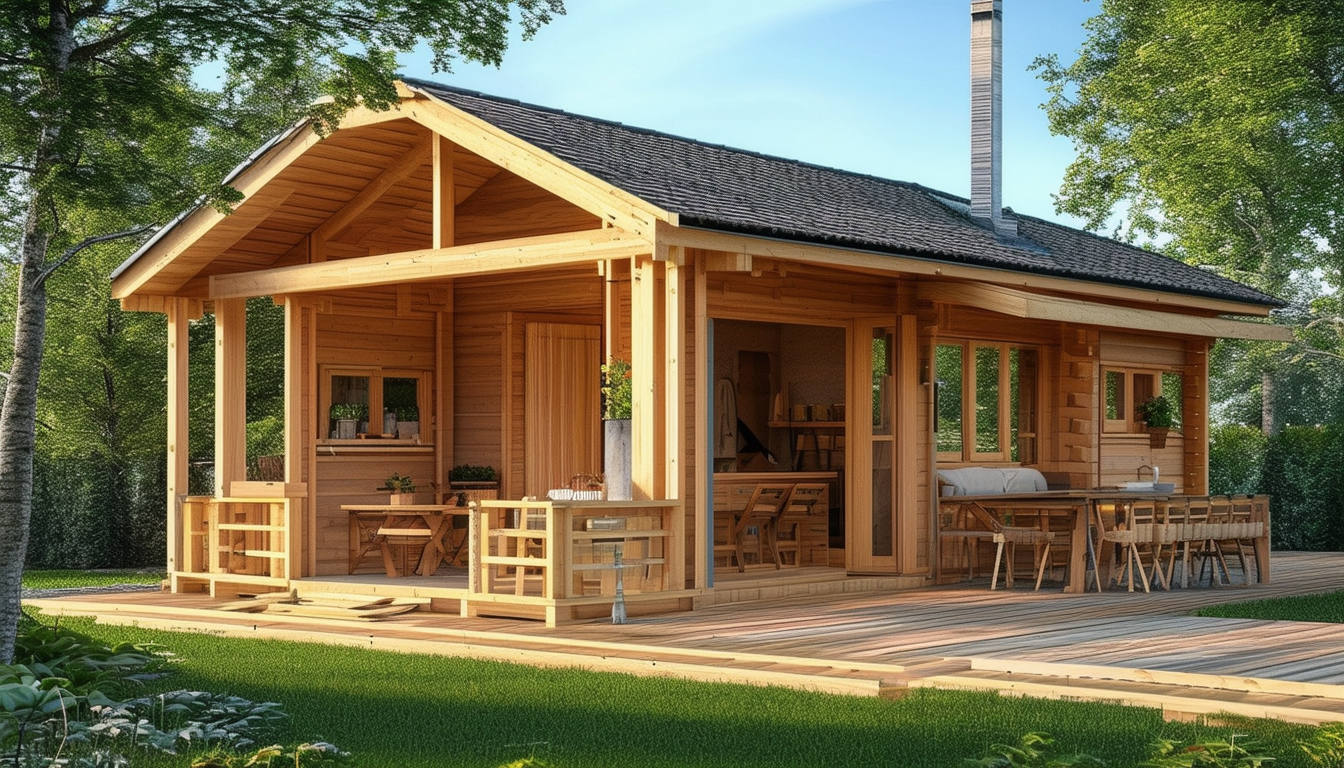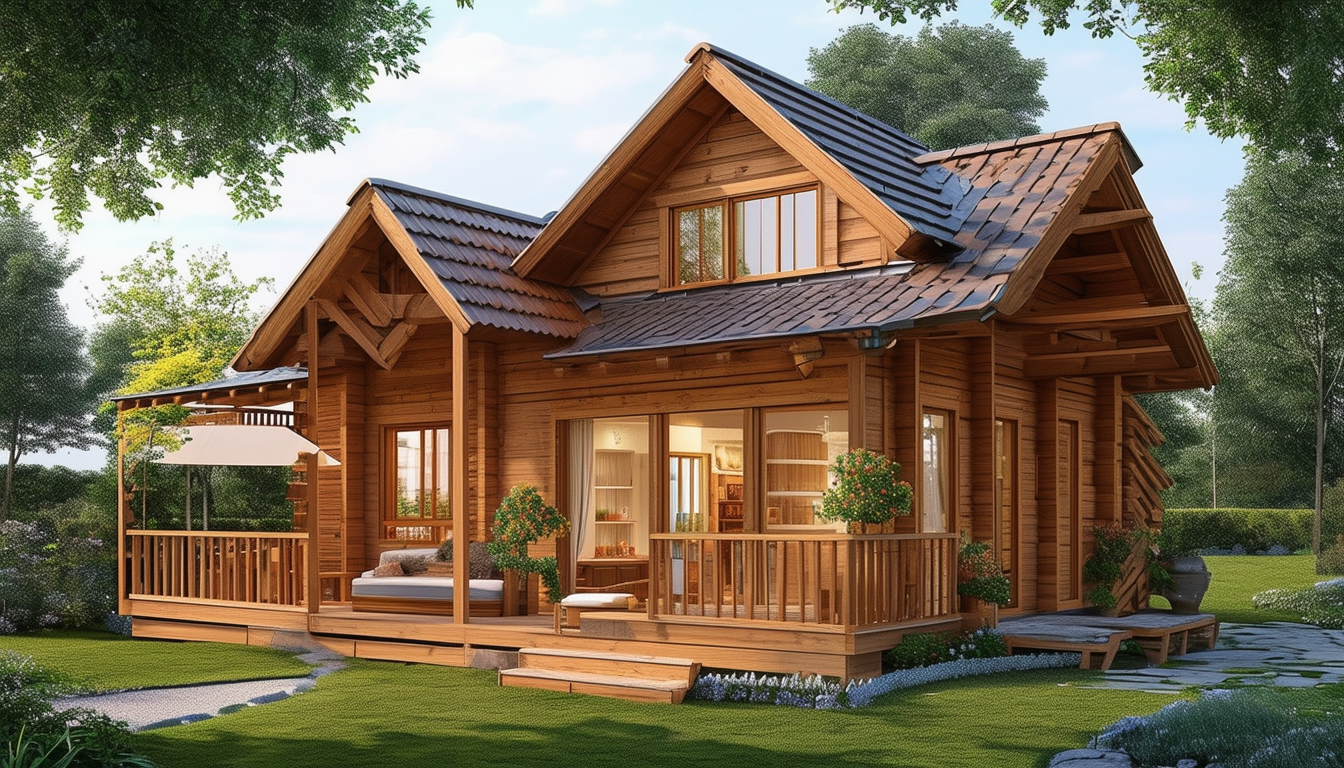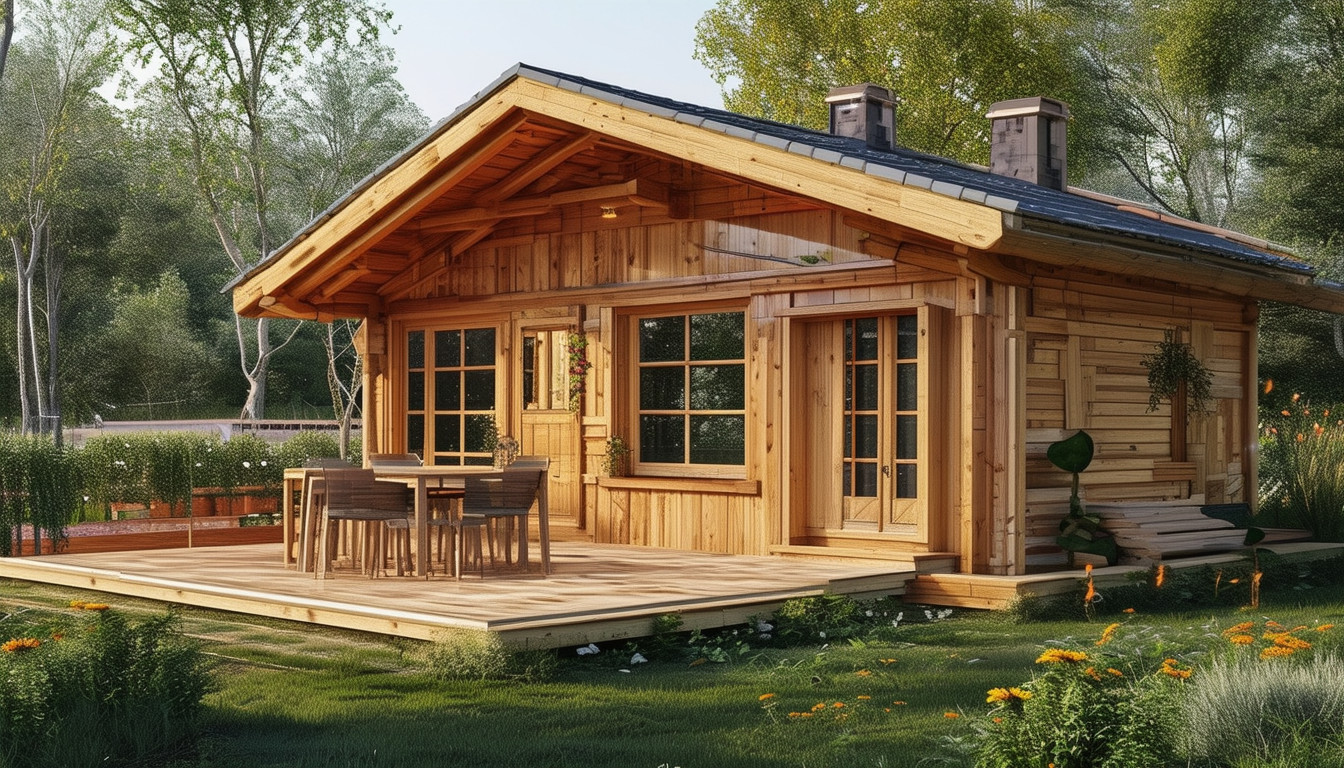Are you considering a lifestyle that aligns with your love for nature and sustainability? Building a wooden house might just be your perfect answer. This article explores the myriad benefits of choosing timber for your home, from its eco-friendly qualities to the serene ambiance it offers. Discover why a wooden house could be the ideal choice for those looking to create a harmonious and sustainable living space.
Durability and Longevity of Wooden Houses

Understanding the Durability of Wooden Homes
Wood has been a staple in residential construction for centuries, primarily due to its availability, ease of use, and natural beauty. However, the longevity of wooden structures often raises questions. Advances in wood treatment and building technology have significantly enhanced the durability of wooden houses today. Properly sourced and treated wood can resist environmental factors such as moisture, pests, and decay, ensuring that wooden homes can stand robustly for generations.
Factors Influencing Wooden House Longevity
The lifespan of a wooden house is influenced by several critical factors. First, the type of wood used plays a pivotal role. Hardwoods like oak and teak, known for their durability, can offer more resistance to wear and tear compared to softer woods like pine. Another crucial factor is the wood treatment processes. Modern methods like chemical preservatives, pressure treatment, and thermal modification extend wood’s resilience against rot, insects, and fungal growth.
Construction techniques also contribute significantly to the longevity of wooden houses. Traditional methods like timber framing and log building, which allow wood to ‘breathe’ and adjust to humidity variations, can enhance durability. Moreover, ensuring good ventilation within the design helps prevent moisture buildup, crucial for preventing rot.
Protective Measures for Extended Lifespan
Maintaining a wooden house requires some dedication to protective measures to ensure its longevity. Regular inspections for any signs of moisture ingress, pest infestation, or wood rot are essential. Prompt repairs in case of any damage can prevent further degradation. Additionally, protective stains and sealants, like those found on Better Homes & Gardens, are vital for safeguarding the wood from UV rays and moisture.
Choosing the right windows from reputable brands can also play a crucial role in protecting wooden homes by preventing moisture and drafts. These elements of construction are not only functional but can also be stylish, as suggested by the options detailed on Architectural Digest.
The Role of Technology in Enhancing Wood Durability
Technology has brought forward innovations that significantly enhance the longevity of wooden houses. Techniques such as Computer Numerical Control (CNC) milling produce precise components that fit perfectly, reducing gaps that could allow moisture entry. Furthermore, developments in synthetic protective coatings offer better resistance against weathering and UV damage than traditional methods.
Integration of sustainable practices in wood sourcing and manufacturing not only supports environmental conservation but also promotes the health of the forests and the quality of the building materials derived from them.
Understanding and leveraging these elements contribute to the longevity and sustainability of wooden homes, making them a viable option for those looking to harmonize with nature while benefiting from modern building innovations.
How to Plan the Ultimate Polynesia Travel Guide?
Embark on an enchanting journey to the idyllic islands of Polynesia with our definitive travel guide. Whether you’re seeking serene beaches, lush landscapes, or rich cultural experiences, this guide offers expert advice and insider tips to ensure your adventure is…
Environmental Benefits of Choosing a Wooden House

Wooden House: Environmental Benefits of Choosing a Wooden House
Natural Insulation Properties
One of the standout environmental benefits of wooden houses is their natural insulation properties. Wood inherently has excellent insulation abilities compared to other building materials. This means that wooden homes tend to maintain a more consistent internal temperature, whether in cold or warm climates, leading to less dependency on heating and cooling systems. Consequently, this can result in significant energy savings and a reduction in the carbon footprint of the home.
Renewable Resource
Wood is a renewable resource, making it an eco-friendly choice in home construction. Managed forestry practices ensure that when trees are cut down for building materials, new ones are planted in their place. This cycle of harvesting and replanting contributes to carbon sequestration, as young trees absorb carbon dioxide from the atmosphere at a rapid rate. By choosing wood from sustainably managed forests, homeowners can contribute to a healthier planet.
Sustainable Production Processes
Compared to the production of other building materials like steel or concrete, wood requires less energy-intensive methods to process. It has a lower carbon footprint in its manufacturing stages, which is crucial for those looking to minimize environmental impact. Detailed insights about the environmental impact of different building materials can be found through research on sustainable home construction.
Biodegradable and Reduces Construction Waste
At the end of its lifecycle, wood remains a biodegradable material, unlike many other construction materials that contribute to landfill waste. Wood can be easily repurposed, recycled, or turned into mulch for garden areas, aligning with zero-waste practices and contributing further to the environmental benefits of this material. To understand more about how wood integrates into sustainable home practices, insights can be gleaned from sources discussing the best mulches and sustainable gardening practices.
Health Benefits and Indoor Environment Quality
Beyond its environmental advantages, living in a wooden house can also benefit your health. Wood helps in creating a more serene indoor environment by regulating humidity and reducing airborne allergens. The natural aspects of wood can also have a calming effect, reducing stress and improving overall wellbeing.
While there are numerous benefits, it is important to consider responsible sourcing and potential impacts such as deforestation and the treatment of wood with chemicals. Opting for untreated, certified wood ensures that the environmental footprint is kept to a minimum. For information on wood sourcing and environmental impacts, platforms dedicated to building materials and their environmental impacts offer comprehensive details.
What are the key features of the Tesla Model S?
In the realm of electric vehicles, the Tesla Model S stands out as a paragon of innovation and luxury. This article delves into its key features, including its impressive range, advanced autopilot systems, and seamless over-the-air software updates, which together…
Customization Options for Wooden Houses

Custom Exterior Elements
One of the unique aspects of building a wooden house is the ability to tailor the exterior to personal tastes. Options such as the type of wood used, the finish, and even the architectural style can make a significant difference. A popular customization is integrating large windows to enhance natural light and provide sweeping views of the surrounding nature. Windows not only transform the aesthetic but also improve energy efficiency. Understanding the costs and benefits of various window options, like those from Andersen Windows or Pella, will help in making an educated choice.
Interior Design Flexibility
The interior of a wooden house offers vast possibilities for customization. From the ceiling beams to the floorboards, every element can reflect the homeowner’s style. Open floor plans are particularly popular, providing a seamless flow throughout the home and a spacious feel. For those considering a more unique addition, a bespoke home library might be the perfect touch, transforming a simple room into a sanctuary of knowledge and peace, perfect for those who cherish quietude and the rustling of pages.
An addition that blends the indoors with the natural environment is the installation of a sauna. A DIY sauna not only enhances the rustic charm of a wooden house but also creates a wellness retreat within your home. Whether it’s a standard or infrared sauna, the choice depends on personal preference and health considerations.
Outdoor Living Enhancements
Extending livable space outdoors can significantly increase the enjoyment of a wooden home. Custom deck areas, pergolas, and gazebos are excellent for those who love nature and outdoor activities. Building a pergola might seem like a daunting project, but with the right planning and resources, it can provide a delightful outdoor area for entertaining or relaxing, surrounded by the landscape.
Incorporating environmentally-friendly landscaping and organic gardens can also reflect a commitment to sustainable living, providing not only a pleasing aesthetic but also practical benefits like fresh produce right at your doorstep.
Technological Integrations
Incorporating technology into a wooden house can vastly improve convenience and energy efficiency. Smart home systems can control lighting, heating, and security, all integrated seamlessly with eco-friendly choices. The best home kits offer advanced technology without compromising the house’s rustic and natural aesthetic, bridging the gap between traditional craftsmanship and modern convenience.
For many, the dream of a wooden house isn’t just about aesthetics but also about creating a space that aligns with their values of sustainability and natural living. Each customization not only enhances the home but also personalizes the living experience, ensuring that the house not only sits in nature but becomes a part of it.
How to make an easy cake recipe?
Welcome to the world of baking where simplicity meets delight! If you’ve ever been intimidated by the elaborate art of baking, fret not. Today, I’ll guide you through a foolproof, easy cake recipe that promises delectable results with minimal fuss.…
Cost Considerations When Building a Wooden House
Initial Costs of Materials and Design
Building a wooden house begins with understanding the cost implications associated with the materials and architectural design. Wood, as a primary material, comes in various types, each with differing price points. Factors such as the choice between softwood or hardwood, or opting for engineered wood products, significantly affect the overall budget. Additionally, the architectural complexity of the design can alter the cost; intricate designs requiring more specialized labor and materials lead to higher expenses.
Labor Costs and Construction Time Frame
The cost of labor is a crucial component to consider when planning the construction of a wooden house. Skilled carpenters and builders are essential for executing a well-structured and sustainable home. The construction duration also impacts costs. A quicker build reduces labor costs but may require more workers simultaneously, potentially increasing the overall expense. On the other hand, a longer construction period, while spreading out labor costs, could result in higher total costs due to prolonged project management and site maintenance.
Site Preparation and Foundation Work
The location where the wooden house is to be built plays a significant role in cost considerations. Site preparation involves clearing the land, which may include tree removal, leveling, and ensuring proper drainage. Additionally, the foundation type, whether slab, crawl space, or basement, varies in cost with each option providing different benefits and challenges in terms of energy efficiency and potential maintenance issues.
Long-Term Costs: Maintenance and Energy Efficiency
While wooden houses provide a natural aesthetic and comfort, they require regular maintenance to safeguard against environmental elements such as moisture and termites. Maintenance includes periodic staining, sealing, and checks for structural integrity. Moreover, energy efficiency should be addressed; well-insulated walls, energy-efficient windows, and properly sealed doors can reduce long-term heating and cooling costs, contributing to a sustainable home environment.
Renovation and Resale Considerations
Future renovation possibilities and the potential resale value also influence the cost of building a wooden house. Wooden structures can be more adaptable to renovations, which might be desirable for adding value to the home. The natural charm and warm aesthetics of wooden homes often appeal to a specific market segment, potentially increasing resale value, as highlighted by discussions on the enhancement of home resale values through specific types of construction.
In the ever-evolving financial landscape, Bitcoin stands as a beacon of potential wealth and technological innovation. This article delves into the complexities of investing in Bitcoin, weighing its risks against its prospective rewards. We will explore the variables influencing Bitcoin’s…
Maintenance Requirements for Wooden Houses
Understanding the Basics of Wooden House Maintenance
Maintaining a wooden house requires a commitment to regular care to preserve its beauty and structural integrity. Unlike homes made from more modern materials, wooden structures are particularly susceptible to weather elements and require specific maintenance strategies. The natural material needs proactive care to prevent deterioration caused by moisture, insects, and aging.
Regular Cleaning and Care
One of the foundational steps in wooden house maintenance is regular cleaning. Dust, dirt, and organic material can accumulate on both the interior and exterior wood surfaces, leading to potential damage over time. For floor surfaces, using a suitable mop can be effective in keeping the wood clean without damaging it with excessive water or harsh chemicals.
It is also advisable to perform deep cleaning of hardwood floors periodically. Techniques and tips detailed by experts can guide homeowners in maintaining their floors without compromising the wood’s quality. Maintaining the cleanliness of wood is not just about aesthetics but also about preserving the material’s integrity.
Protecting Against Pests and Rot
Wood is naturally prone to pest infestations and rot if not properly treated or maintained. Routine inspections to check for signs of termites, beetles, and other wood-damaging pests are critical. Areas with high humidity levels require more frequent checks and potentially additional treatments to the wood to prevent rot. Sealing wood with appropriate chemicals or using pressure-treated wood can help protect against these threats. Annual or bi-annual treatments using reliable products are recommended to enhance the wood’s resistance to pests and decay.
Weatherproofing Your Wooden House
Weather conditions pose a significant threat to wooden houses. Proper weatherproofing involves treating the wood with sealants and stains that not only enhance the wood’s appearance but also protect it from moisture, UV rays, and temperature fluctuations. Reapplying protective coats according to the manufacturer’s recommendations can significantly extend the life of your wooden house. For those looking into effective wood stains and sealants, Consumer Reports offers insights into top-rated products that can offer the best protection.
Addressing Repairs Promptly
Minor issues such as cracks, splits, or loosened joints should be addressed promptly before they evolve into major repair projects. Wood filler can repair smaller imperfections, while larger issues might require the replacement of wood sections. Understanding when to repair versus replace can save significant amounts of money and maintain the structural and aesthetic value of the house.
Professional Assessments and Maintenance
While much of the maintenance can be handled by the homeowners, certain aspects such as structural assessments and complex repairs should be performed by professionals. Experts can provide more thorough inspections, identify hidden problems, and ensure that repairs are carried out effectively and safely. Engaging professionals periodically also helps in getting an unbiased assessment of the maintenance needs of your wooden house.
By adhering to these maintenance strategies, homeowners can ensure their wooden houses remain beautiful and sturdy for years to come, thus preserving their natural appeal and functionality. Regular attention and care tailored to the specific needs and environmental conditions of the house are essential for the longevity of any wooden structure.
Energy Efficiency of Wooden Houses
Wooden House: Energy Efficiency of Wooden Houses
The growing interest in environmentally sustainable building practices has brought significant attention to the energy efficiency of wooden houses. Wood, as a natural insulator, offers exceptional benefits in reducing energy consumption, making it a preferred choice for eco-conscious homeowners and builders.
Thermal Insulation Properties of Wood
One of the primary factors contributing to the energy efficiency of wooden houses is wood’s natural thermal insulation properties. Wood contains tiny air pockets which limit its ability to conduct heat. This makes wooden structures naturally warmer in the winter and cooler in the summer, reducing the need for artificial heating and cooling. For individuals keen on sustainable living, such as those interested in homes that complement natural surroundings without compromising on modern comforts, wooden houses offer an ideal solution.
Energy Saving Through Architectural Design
Incorporating wood in architectural designs not only appeals aesthetically but also enhances the energy efficiency of buildings. The flexibility of wood allows for innovative designs that can maximize natural light and ventilation, thereby decreasing the reliance on electrical lighting and air conditioning. By smartly integrating features such as large wooden windows and strategically placed skylights, homeowners can achieve significant energy savings. More about these smart architectural incorporations can be found here.
Comparative Analysis with Other Building Materials
When compared to materials like concrete or steel, wood stands out for its excellent insulating properties. A comparative study of building materials shows that wooden structures generally require less energy to heat and cool, which translates into lower utility bills and reduced carbon emissions. This aspect is particularly appealing to those who prioritize environmental friendliness without compromising on living standards.
Longevity and Lifecycle Impact of Wooden Houses
Another significant aspect of wooden houses is their durability and the sustainability of wood as a building material. With proper maintenance, wooden structures can last for generations, thereby reducing the need for frequent renovations or rebuilds. This long lifespan contributes to the sustainability of wooden houses, as it minimizes waste and decreases the demand for new materials. The sustainable sourcing of wood, including practices like managed forestry and the use of reclaimed timber, further enhances the environmental profile of wooden buildings.
Moreover, wood’s capacity for carbon sequestration means that wooden buildings play a direct role in combating climate change. By storing carbon dioxide, wooden houses reduce the amount of this greenhouse gas in the atmosphere, which is a vital step towards a more sustainable planet.
Integrating Technology for Enhanced Efficiency
The integration of modern technologies can enhance the natural energy efficiency of wooden houses. Smart home technologies, such as automated thermostats and energy-efficient appliances, work synergistically with wood’s natural properties to create a highly efficient living environment. Techniques such as solar panel installation and the use of energy-efficient windows further boost the eco-credentials of wooden homes. Detailed insights into state-of-the-art energy-saving technologies in wooden homes can be explored here.
In conclusion, wooden houses not only bridge the gap between traditional charm and modern efficiency but also contribute significantly to environmental conservation. The energy efficiency derived from the natural properties of wood, combined with advanced architectural designs and technologies, makes wooden houses an increasingly popular choice for sustainable living.
Resale Value of Wooden Houses
Factors Influencing the Resale Value of Wooden Houses
Understanding the potential resale value of wooden houses involves examining several influential factors. Factors such as location, maintenance history, and the age of the property play pivotal roles. Naturally, homes located in desirable neighborhoods, especially those that blend seamlessly with their natural surroundings and meet modern sustainability standards, often fetch higher resale values. Additionally, wooden houses that have been well-maintained over the years demonstrate to potential buyers that the property is a worthwhile investment.
Market Trends and Buyer Preferences
The real estate market continually evolves, and trends within this market significantly impact the resale value of properties, including wooden houses. Currently, there is a growing preference among homebuyers for eco-friendly and sustainable living spaces. Wooden houses, known for their charm and sustainable qualities, are increasingly popular among environmentally conscious buyers. This shift is reflected in property listings and real estate reports where wooden houses often command a premium, especially those that effectively integrate modern amenities while preserving their rustic charm.
Comparative Analysis of Wooden Houses versus Other House Types
When considering the resale value of wooden houses, it’s crucial to perform a comparative analysis with other types of properties. Wooden houses can be compared to homes constructed from more traditional materials like brick or concrete in terms of durability, maintenance needs, and aesthetic appeal. While wooden homes may require more maintenance, their unique aesthetic and environmental benefits often place them in a favorable position in the housing market. Studies, such as those referenced by real estate experts in a recent New York Times article, have highlighted shifts in buyer preferences towards unique and character-rich homes.
Long-Term Investment and Cost-Effectiveness
Investing in a wooden house can be seen as a long-term investment. Owners who are diligent in maintaining their property can see significant appreciation in value over time. Additionally, the cost-effectiveness of building and renovating wooden homes, as compared to more resource-intensive materials, makes them an attractive option for savvy investors and homeowners alike. The potential for upgrading a wooden house to enhance its energy efficiency or to implement smart home technologies often results in increased property values. An example of market appreciation for unique properties can be found in specialized listings and real estate analyses, such as those on Bob Vila’s website, indicating a higher willingness among buyers to pay more for distinctive features and sustainable design.








